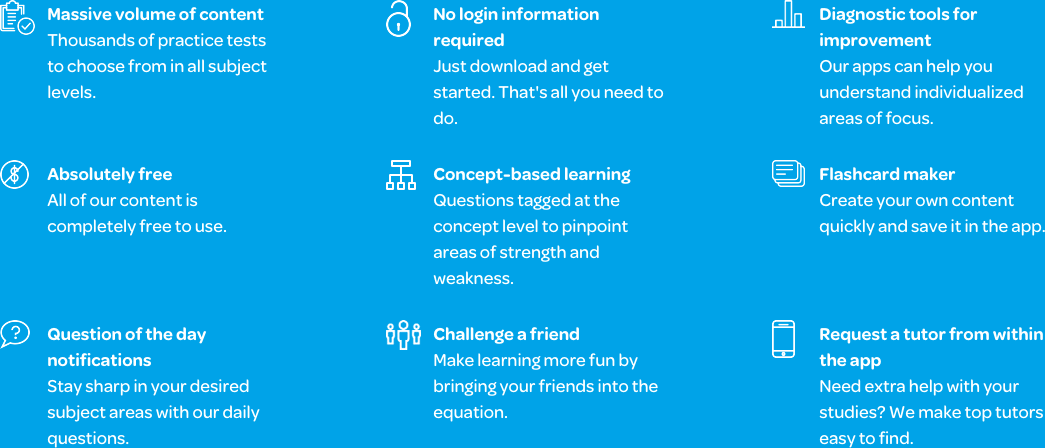The Varsity Tutors AP Chemistry Mobile App
The AP Chemistry exam covers many advanced subjects. Students need a thorough understanding of chemical bonding, atomic theory, thermodynamics, and the various phases of matter. Preparing for this three-hour test is made simpler by using the free Varsity Tutors AP Chemistry app for Android, iPhone, and iPad, available now from the Google Play Store and iTunes.
In AP Chemistry, students team up to work out analytical problems and create experiments based on their own questions. It is a very hands-on course, as students participate in laboratory exercises to learn key concepts. Their observations and experiences provide an engaging way to learn about matter, forces, and reactions while practicing how to perfect chemical calculations.
One quarter of the course will be spent on laboratory requirements. Students participate in at least 16 hands-on labs. Some of these are inquiry-based investigations. In these, students formulate their own hypotheses. They are encouraged to make predictions and design the experiments independently, and students are able to track their progress throughout the course.
On the AP Chemistry Exam, students are tested on a full year’s worth of coursework. Section I consists of 60 multiple-choice questions, which students have 105 minutes to answer. Section II is a 90-minute free response that asks students to answer three long questions and four short questions. Each section accounts for half of the total test score. While a scientific calculator may be used for the free-response section, succeeding on the exam will still require practice. This is where the app’s features prove to be most useful.
The practice questions and full-length practice tests cover the same material as the test. In addition to multiple-choice questions, one can test their experiment design and analysis skills with exercises that mimic the free response content. Students can also practice solving problems and seeing patterns among data.
The app includes a Tests Taken feature. Detailed feedback lets students track their progress and analyze their scores in the same way as on the real exam. They can easily measure the time taken to answer questions, which can not only help with problem areas, but also aid in time management.
Detailed explanations of answers are provided as well. If a student answers the problem incorrectly, they can spend time reading up on it directly through the app using their Android or Apple device. Pre-designed flashcards are available, but students can also create their own using images of content such as equations, audio from lessons, and photos. The Varsity Tutors AP Chemistry app for Android, iPhone, and iPad is suited for every type of student, no matter how they learn best.
From the building blocks of matter to the laws of thermodynamics, AP Chemistry teaches students how the world around them works. The skills learned enable them to understand changes in matter and analyze rates of chemical reactions. Available on iTunes and the Google Play Store, Varsity Tutors’ AP Chemistry app for Android, iPhone, and iPad is a great supplement that enables students to work toward mastering the topics they’ll need to know for the big test.
66 mobile apps to choose from for your tutoring needs.

Learn More
If you’re looking for a college-level foundation in the field of chemistry, AP Chemistry is the right path to take. The course explores atomic structure, chemical reactions, intermolecular forces, bonding, thermodynamics, equilibrium, and many other concepts that explain the technical workings of the world. As with other subjects in the Advanced Placement program, you are given the opportunity to do college-level coursework in high school. You can even earn college credits if the post-secondary institution you choose, or are accepted into, is willing to recognize your advanced abilities.
You will work in a laboratory, which is one of the things that makes AP Chemistry so unique. Twenty-five percent of the instructional time is spent investigating theories and experiments. There are at least 16 hands-on laboratory lessons. Six of them require an inquiry-based approach. The rest of the time you will be exploring core scientific principles, processes, and theories. From the chemical elements to chemical and physical properties of materials, the course content moves on to include changes in matter resulting from the reorganization of atoms and/or electron transfer. You’ll learn the laws of thermodynamics, and about the attraction and breaking of bonds.
When it comes to the AP Chemistry test, you are going to have to know many principles. Mathematics, scientific questioning, data analysis, and interconnections of knowledge are involved. You will have three hours and fifteen minutes to complete the exam. It involves working with symbolic representations of ideas, often mathematically, and being able to design and explain experiments. Data and error analysis, reasoning, justifications, and interpretation of conceptual models are all activities you’ll need to do in order to pass. You’ll be working with the periodic table of elements, as well as formulas and constants.
Section I of the AP Chemistry Exam has 60 multiple-choice questions. You’ll have 90 minutes to answer all of them; some of the content will be discrete items and other items will be in sets. This segment is 50 percent of the total score. Section II is the free response part of the exam. It has seven questions, which you have 105 minutes to answer. This section comprises the other half of your total score. You’ll have to answer three long questions and four short-answer ones. Content will include experimental design, and you will have to make observations in order to identify patterns and explain the phenomena that are being represented by the question. The problems will require you to analyze or create atomic and molecular representations. Using logic and analytics, you will have to solve problems correctly to show that you’ve mastered the material you have learned over the course of AP Chemistry.
The overall course consists of six Big Ideas. These include Structure of Matter, Bonding and Intermolecular Forces, Chemical Reactions, Kinetics, Thermodynamics, and Chemical Equilibrium. The seven scientific practices involved are: drawing, explaining, and interpreting representations; using math and logic; asking and refining the appropriate scientific questions; and designing and implementing methods of data collection. You also have to make predictions, justifying your claims, and connect various concepts across the Big Ideas.
AP Chemistry focuses on the chemical elements as fundamental building blocks. The idea is that all matter can be analyzed by how the atoms are arranged, and will maintain their identity regardless of the chemical reaction they undergo. Chemistry’s fundamental premise is the atomic theory of matter. You’ll learn that all matter is made of atoms, and that the number of types of atoms that exist is limited. Next, the combinations of atoms that make up molecules are explained. Different elements combine to create different molecules. You will become familiar with the idea of chemical analysis in determining how many atoms are in a substance, what the substance is, and how to count the numbers of particles on a macroscopic level.
During the course, the shell model will be introduced. Each element’s atoms have a unique structure, which is based on how the electrons and nuclei interact. How electrons are attracted to the nucleus is covered, and you’ll learn more about the structure of an atom through Coulomb’s law. You will get comprehensive lessons on the configuration of electrons, shells, and energy levels. The concept of periodicity helps understand atomic properties and to predict them, and you will get a good look at the quantum mechanical model as well, which integrates previous concepts learned and expands on all of the atomic principles previously covered in the course.
Early atomic models are integrated into the coursework, but you will also get a look in the world of mass spectrometry, which contradicts the earliest atomic model. You’ll learn how the interaction of light with matter helps probe atomic and molecular structure. The AP Chemistry course moves on explain chemical and physical properties in regards to the structure and arrangement of atoms, molecules, and ions, and also the forces that interact between them. This segment focuses on describing matter physically, whether it is a solid or a liquid. A definition of gas comes next. You’ll also get a look into forces of attraction, intermolecular forces, covalent bonding, ionic bonding, and metallic bonding.
Moving forward, you’ll learn how changes in matter require a rearrangement or reorganization of atoms. Oftentimes this requires just a transfer of electrons. The course covers how to classify chemical reactions as decomposition, synthesis, acid-base, or oxidation-reduction. You’ll then learn the details of molecular collisions and how to identify these in order to determine the rates of chemical reactions. In learning about thermodynamics, you’ll be able to identify the role energy has in predicting how matter will change. Next, you’ll see how the processes of intermolecular attraction and bond breaking are so competitive.
The exercises and experiments of AP Chemistry involve using scientific models, formulas, and graphs to reason with the principles mathematically. The engagement and questioning are intensive, but give you a first-hand look into the basic concepts of atomic and molecular science. Through evaluation, investigation, and observation, you can not only complete the course and exam, but better understand the world that surrounds you.




